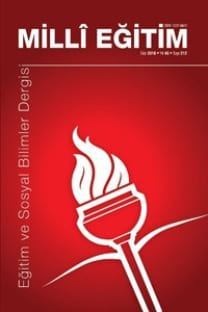SÖZCÜKSEL KAYNAK KULLANIMININ İKİNCİ DİLDE YAZMADA SÖZCÜKSEL ZENGİNLİĞE ETKİLERİ
Bu çalışma, sözlük ve eş anlamlılar sözlüğü kullanımının, ikinci dilde yazmada sözcüksel zenginliğin bileşenlerinden olan nadir ve çeşitli sözcük kullanımına olan etkisini incelemektedir. Türkiye’de bir devlet üniversitesinin İngilizce hazırlık programına kayıtlı 27 öğrenci, derslerinin bir parçası olarak okul dışında bir kompozisyon yazıp teslim etmiş ve daha sonra bu öğrencilere nadir ve çeşitli sözcük kullanımı hakkında kısa bir eğitim verilmiştir. Bu eğitimi takiben öğrencilerden yazmış oldukları kompozisyonları sözlük ve eş anlamlılar sözlüğü kullanarak düzeltmeleri istenmiştir. Okul dışında yazılan kompozisyonlar düzeltilen kompozisyonlarla karşılaştırıldığında sözlük ve eş anlamlılar sözlüğü kullanarak yapılan düzeltmelerin nadir sözcük kullanımında anlamlı bir artış meydana getirdiği görülmüştür. Biri hariç olmak üzere, çeşitli sözcük kullanımını ölçen araçlarda da anlamlı artışlar bulunmuştur. Kelime çeşitliliğiyle ilgili olarak elde edilen farklı bulgular, kullanılan sözcük ölçme araçlarının kendilerine has özellikleri üzerinden tartışılacaktır.
Anahtar Kelimeler:
sözcüksel zenginlik, ikinci dilde yazma, revizyon, sözlük
THE EFFECTS OF VOCABULARY RESOURCE USE ON LEXICAL RICHNESS IN L2 WRITING
This study investigates the effects of dictionary and thesaurus use on lexical sophistication and variation, two of the components of lexical richness in second language (L2) writing. After writing a take-home essay as part of their studies, 27 learners enrolled in an English preparatory program at a state university in Turkey received brief instructions in lexical sophistication and variation. Following the instructions, the learners were asked to revise their essays by using a dictionary and a thesaurus. A comparison of the take-home essays and their revised versions showed that revising take-home essays with the help of vocabulary resources led to a significant increase in lexical sophistication. Significant increases were also found for the measures used for lexical variation, except one of them. The different results obtained for lexical variation will be discussed in relation to the specific characteristics of the lexical measures used.
Keywords:
dictionary, revision, L2 writing, lexical richness,
___
- Ai, H., & Lu, X. (2010, June). A web-based system for automatic measurement of lexical complexity. Paper presented at the 27th Annual Symposium of the Computer-Assisted Language Consortium (CALICO-10), Amherst, MA.
- Arnaud, P. J. L., & Savignon, S. J. (1997). Rare words, complex lexical units and the advanced learner. In J. Coady & T. Huckin (Eds.), Second language vocabulary acquisition: A rationale for pedagogy (pp. 157-173). Cambridge: Cambridge University Press.
- Carruthers, F. (2017, July 20). My reverse culture shock: returning from a year abroad is tough. The Guardian. Retrieved from https://www.theguardian.com/uk-news
- Daller, H., van Hout, R., & Treffers-Daller, J. (2003). Lexical richness in the spontaneous speech of bilinguals. Applied Linguistics, 24(2), 197-222.
- East, M. (2007). Bilingual dictionaries in tests of L2 writing proficiency: Do they make a difference? Language Testing, 24(3), 331-353.
- East, M. (2008). Dictionary use in foreign language writing exams: Impact and implications. Amsterdam: John Benjamins B.V.
- Gebril, A., & Plakans, L. (2016). Source-based tasks in academic writing assessment: Lexical diversity, textual borrowing and proficiency. Journal of English for Academic Purposes, 24, 78-88.
- Johnson, W. (1944) Studies in language behavior: I. A program of research. Psychological Monographs, 56(2), pp. 1-15.
- Johnson, M. D., Mercado, L., & Acevedo, A. (2012). The effect of planning sub-processes on L2 writing fluency, grammatical complexity, and lexical complexity. Journal of Second Language Writing, 21(3), 264-282.
- Laufer, B. (1991). The development of L2 lexis in the expression of the advanced learner. The Modern Language Journal, 75(4), 440-448.
- Laufer, B. (1994). The lexical profile of second language writing: Does it change over time? RELC Journal, 25(2), 21- 33.
- Laufer, B. & Nation, P. (1995). Vocabulary size and use: Lexical richness in L2 written production. Applied Linguistics, 16(3), 307-322.
- Linnarud, M. (1983). On lexis: The Swedish learner and the native speaker compared. In K. Sajavaara (Ed.), Cross-language analysis and second language acquisition 2, (pp. 249-261). Jyväskylä: University of Jyväskylä.
- Lu, X. (2012). The relationship of lexical richness to the quality of ESL learners’ oral narratives. The Modern Language Journal, 96(2), 190-208.
- Malvern, D. D., Richards, B. J., Chipere, N., & Durán, P. (2004). Lexical diversity and language development: Quantification and assessment. Houndmills: Palgrave Macmillan.
- Mazgutova, D., & Kormos, J. (2015). Syntactic and lexical development in an intensive English for academic purposes programme. Journal of Second Language Writing, 29, 3-15.
- Meara, P., & Bell, H. (2001). P_Lex: A simple and effective way of describing the lexical characteristics of short L2 texts. Prospect, 16(3), 5-19.
- Ong, J., & Zhang, L. J. (2010). Effects of task complexity on the fluency and lexical complexity in EFL students’ argumentative writing. Journal of Second Language Writing, 19(4), 218-233.
- Polat, B., & Kim, Y. (2014). Dynamics of complexity and accuracy: A longitudinal case study of advanced untutored development. Applied Linguistics, 35(2), 184-207.
- Read, J. (2000). Assessing vocabulary. Cambridge: Cambridge University Press.
- Saito, K., Webb, S., Trofimovich, P., & Isaacs, T. (2016). Lexical profiles of comprehensible second language speech: The role of appropriateness, fluency, variation, sophistication, abstractness, and sense relations. Studies in Second Language Acquisition, 38(4), 677-701.
- Schmitt, N. (2000). Vocabulary in language teaching. Cambridge: Cambridge University Press.
- Vermeer, A. (2000). Coming to grips with lexical richness in spontaneous speech data. Language Testing, 17(1), 65-83.
- Xue, G., & Nation, I. S. P. (1984). A university word list. Language Learning and Communication, 3(2), 215-229.
- ISSN: 1302-5600
- Yayın Aralığı: Yılda 4 Sayı
- Başlangıç: 1973
- Yayıncı: Milli Eğitim Bakanlığı
Sayıdaki Diğer Makaleler
ÇOCUK KİTAPLARINDA AKRAN ZORBALIĞI
Oğuzhan YILMAZ, Bilge DESTEGÜLOĞLU
Derya ŞAHİN, Özlem GÖZÜN KAHRAMAN
ÖĞRETMEN TEMALI FİLMLERDE SUNULAN “İDEAL ÖĞRETMEN” MODELİ
Müzeyyen ALTUNBAY, Julide ALACA
OKUL YÖNETİCİLERİ VE ÖĞRETMENLERDE AZİM VE PSİKOLOJİK SAĞLAMLIĞIN ROLÜ
ERGENLERDE DUYGU DÜZENLEME STRATEJİLERİ VE EBEVEYN TUTUMLARI ARASINDAKİ İLİŞKİNİN İNCELENMESİ
PIAAC 2015 YETİŞKİN BECERİLERİNİN MEB ÇALIŞANLARININ GÖRÜŞLERİNE GÖRE DEĞERLENDİRİLMESİ
ÖĞRETMENLERİN LİSE PANSİYONLARINA İLİŞKİN GÖRÜŞLERİ: PROBLEMLER VE ÇÖZÜM ÖNERİLERİ
